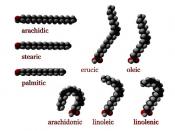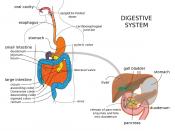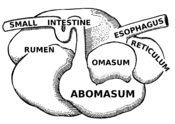Digestive System Assignment
Introduction: Digestion is the process of breaking down food into smaller molecules that can be absorbed into the bloodstream.
The digestive systems most important function is to provide the body with ENERGY. Other functions include:
÷Aid in the digestion and metabolism of food
÷Muscle contraction
÷Circulation and formation of blood cells
÷Building new tissues-maintenance and repair
÷Nerve transmission
÷Maintain body temperature
Physical digestion is when the food molecules are broken down into smaller pieces by the digestive systems organs to enable it to be processed by the body.
Chemical digestion occurs when special chemicals called enzymes break down the already small molecules even smaller. From there three chemical reactions take place, depending on what food type is being digested.
Protein: The protein contained in the burger enters the mouth where the teeth grind and chew it into smaller pieces. This is physical digestion. It then enters the stomach, which is where the digestive process begins.
The presence of food in the stomach stimulates the stomach walls to produce gastric juices containing a hydrochloric acid, mucus and enzymes called pepsin and protease, which begins the digestion of the proteins. The hydrochloric acid provides acidic conditions needed for the enzyme protease. This is also known as chemical digestion. In the stomach some proteins are broken down into smaller particles called polypeptides. From here the particles travel into the small intestine, which is the longest part of the digestive tract. Enzymes released from the pancreas and liver continue the breakdown of proteins, polypeptides and peptides and eventually amino acids, which are absorbed through the intestinal wall into the bloodstream. From there they are delivered to organs and tissues for maintenance, repair and growth. If the amino acids are not needed, they are broken down into urea and glucose. The urea...


